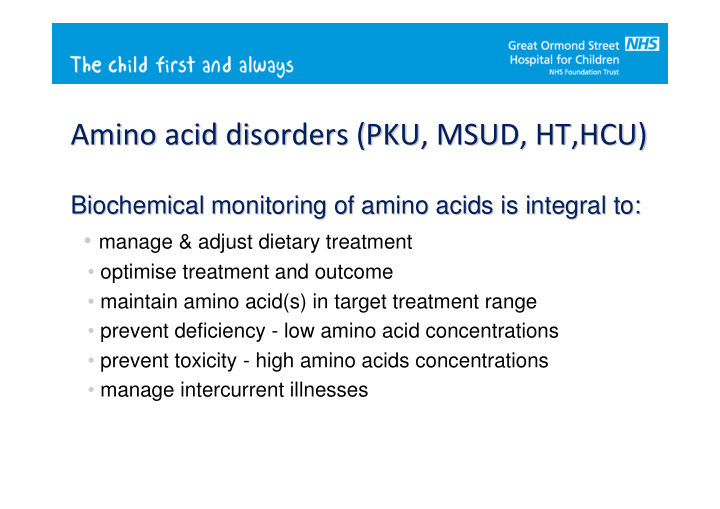



Amino acid disorders (PKU, MSUD, HT,HCU) Amino acid disorders (PKU, MSUD, HT,HCU) Biochemical monitoring of amino acids is integral to: Biochemical monitoring of amino acids is integral to: • manage & adjust dietary treatment • optimise treatment and outcome • maintain amino acid(s) in target treatment range • prevent deficiency - low amino acid concentrations • prevent toxicity - high amino acids concentrations • manage intercurrent illnesses
Amino acid disorders (PKU, MSUD, HT,HCU) Amino acid disorders (PKU, MSUD, HT,HCU) • accumulation of precursor amino acid(s) in plasma • measure the accumulating amino acid(s) • normal reference ranges • target treatment reference ranges for amino acid(s) • target plasma reference range >normal reference range • measurement of uncertainty (MU) • adjust diet based on result and other factors • families informed of result by phone, letter, e-mail, text, graph of results at clinic
Home blood sampling and collection Home blood sampling and collection • blood spot on blood cards (PKU, Tyr, MSUD, HCU) - heel/finger prick - importance of good sample to obtain accurate results ! - convenient, simple, achievable - enables regular, accurate monitoring of diet • blood in Sarstedt microvette tube
Frequency of blood sampling: a guide Frequency of blood sampling: a guide PKU, MSUD, HT(1,11,111) • weekly in infancy and early childhood • 2 weekly in toddlers, young children • monthly in older children HCU: • less easy to monitor from home • hospital phlebotomy for prompt blood separation • dried blood spot for tHc (LC–MS/MS), methionine (Adam Gerrard, Mary Anne Preece, BCH) • weekly in infants until stable, then 2 weekly
Sampling time of day – – standardise ? standardise ? Sampling time of day • diurnal variation of amino acids • ideally sample at least 3½ hours after end of last meal, avoid high aa’s due to postprandial absorption Bachmann C, J Inher Metab Dis 2008 • PKU - phenylalanine is highest after overnight fast Macdonald A et al, Arch Dis Child 1997 • aim is to at least collect at same time of day eg: PKU bath time on a Sunday – warm, good blood flow • try to document time delay between last meal & sampling
Tandem mass spectrometry (MS/MS) - blood spots for • for PKU, Tyrosinaemia • HCU (and paired plasma sample 1/mth) Ultra High performance/pressure liquid chromatography • BCAA blood spot Results • daily - phe, tyr, BCAA • weekly - tHc, methionine (BCH)
Interpretation of amino acid results Interpretation of amino acid results • look at trends • adjust diet • repeat blood test to follow up dietary change • timing of sample in relation to food • consider clinical status - is child well ? - is child on ER ? • growth • age (puberty) • compliance with diet • no of days since last increased exchanges/protein
Reasons for high concentrations of Reasons for high concentrations of amino acid(s) on treatment amino acid(s) on treatment • acute catabolism: infection, stress, surgery • chronic catabolism due to inadequate intake of: - precursor free aa’s - energy • too much natural protein • wrong protein substitute product or low protein foods • non-adherence • medicine (Betaine in HCU)
Reasons for low concentrations of Reasons for low concentrations of amino acids (s) on treatment amino acids (s) on treatment • inadequate natural protein intake • inadequate protein substitute or single amino acids • increased requirement post illness • growth spurt • inadequate synthesis and supplementation • cysteine - HCU • tyrosine - PKU
Treatment aim Treatment aim PKU Phe range µmol/l Phe range µmol/l Age(years) MRC Arch Dis Child European PKU Guidelines 1993 2016 (unpublished) 0-4 120-360 (35-100 normal) 120-360 5-10 120-480 120-360 >11 120-700 120-600
Plasma reference ranges µmol/l MSUD normal target treatment range Leucine 65-220 200-400 75-200 < 5y 75-300 > 5y Isoleucine 26-100 200-400 Valine 90-300 200-400 Frazier DM et al, 2014
MSUD - - age 4 mths age 4 mths MSUD BCAA monitoring BCAA monitoring
Tyrosinaemia Plasma reference ranges µmol/l type 1 normal blood spot treatment aims Tyrosine 30 -120 200 - 400 Phenylalanine 35 -100 35 -100
HT1 – teenager age 13 years Diet:13g natural protein, Tyr Cooler x 3 (45g aa’s) Date Tyrosine Phenylalanine aim 200-400µmol/l 35-100µmol/l 14.11.09 am 557 34 pm 398 75 05.12.09 am 747 64 pm 589 53 05.01.10 am 986 100 pm 925 70 16.01.10 am 458 51 pm 361 36 23.01.10 am 388 33
HCU Treatment aims plasma homocysteine cysteine free total methionine µmol/l µmol/l µmol/l µmol/l diet alone normal normal < 10 < 80 -100 range range betaine high up to normal < 10 < 80 -100 1000 range • Lifetime - free Hcy <10 µmol/l associated with good outcome • tHcy > 60µmol/l before observe free Hcy • Dried blood spot - apply a factor of x 4
Summary Summary • biochemical monitoring is integral to dietetic management • monitoring both single and trends of results is important • repeated/regular monitoring to review interventions • cannot interpret in isolation need to consider other factors - clinical picture, growth, dietary intake, compliance
Measurement of uncertainty Measurement of uncertainty • should MU be considered when interpreting results for monitoring? • would it be helpful to have MU reported with results ? • is this more of a problem for higher results ? - apply same MU then greater range - Leuc 400 � mol/L (apply MU of 15) = 340 to 460 - Leuc 800 � mol/L (apply MU of 15) = 680 to 920
Recommend
More recommend